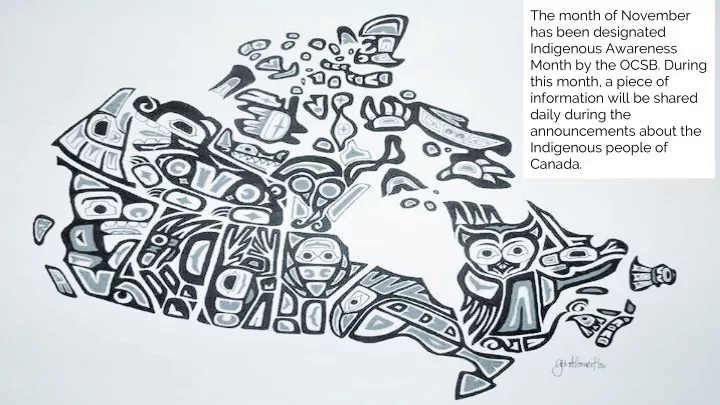

The month of November has been designated Indigenous Awareness Month by the OCSB. During this month, a piece of information will be shared daily during the announcements about the Indigenous people of Canada.
The term to represent the first people of Canada is Indigenous (autochtones in French), Aboriginal is no longer used in Canada Canada has three main Indigenous groups. First Nations (634 First Nations in Canada), Métis and the Inuit.
As of the 2016 census, 1 673 785 Canadians self-identify as being either First Nations, Métis or Inuit representing 4.9% of the Canadian population.
There are over 70 different Indigenous languages in Learn to count to 5 in Algonquin: Canada. The most spoken language is Cree in the Algonquian language family with 96 575 speakers. The One Pejig Two Nìj least spoken is Kutenai spoken in some parts of British Three Niswi Columbia with 170 speakers. Four New Five Nànan Stats Can 2017
The first week of November is designated as Treaty Recognition Week in Ontario. Ottawa is located on the traditional, unsurrendered and unceded land of the Algonquin. The land we are on was never part of any treaty between the Algonquin and Government, and therefore the land remains Algonquin territory today. The Algonquin are in the midst of a land claim with all levels of government.
Only the First Nations signed treaties with the Government. They were promised land reserves (reservations is the American term), tools (hunting, fishing, farming), healthcare and education. In return the Government had promises of peace, law and order, and prohibition of alcohol. The Numbered Treaties (1-11) allowed the development of the West as well as the discovery and mining of many minerals (Gold Rush).
Most First Nations have oral traditions and trade agreements were made this way; never written, only told. When Europeans arrived and wanted written agreements, most Chiefs were unable to write their names. They signed with their x mark or their clan symbol (crane, loon, fish, bear, deer, marten, bird).
Europeans signed the treaties on paper. Treaties were meant to exist “as long as the grass grows, river flows and sun shines”. However, paper eventually breaks down, the First Nations fear of the treaties. First Nations created Wampum belts made of quahog shells. They represented either the signees of the treaty or the treaty itself. This belt represents the Iroquois Confederacy between the Seneca, Cayuga, Onondaga, Oneida and the Mohawk.
Francis Pegahmagabow is Canada's highest and most decorated Indigenous soldier. He fought during WW1, credited with being the most effective sniper in the war, killing 378 enemy soldiers and capturing 300 more. Decorated with the Military Medal, British War Medal and Victory Medal, he died in 1952 at the age of 61.
Indigenous people are credited with the discovery of or creation of: corn, potatoes, tomatoes, canoes, parkas, lacrosse, toboggans and much more.
Ottawa`s name is from the Algonquin language, deriving from adawe meaning to trade. . Ontario means either great lake from the Huron language or skanadario meaning beautiful water from Iroquois . Canada comes from the word kanata from Huron-Iroquois language for village.
There are just over 65 000 people who self-identify as being Inuit. Ottawa has the largest Inuit population south of the Arctic with an estimated 3000 Inuit inhabitants. Did you know that the Inuit are credited with the creation of snow goggles to battle snow blindness which led to modern day sunglasses.
The Métis people were born in Eastern Canada. They were the children born to European settlers and First Nations wives. Their flag represents two cultures coming together and never coming apart.
Louis Riel, a Métis leader, known as a hero to the Métis or a traitor to the Canadian government of his era. Riel fought to preserve Métis rights and culture as Canada was further developing westward. He led two movements — the Red River Rebellion in Manitoba in 1869-1870 and the Northwest Rebellion in Saskatchewan in 1885. Thomas Scott, a member of the Government’s response to the threats in Manitoba was executed in 1870 by Riel’s forces. Riel fled to the United States returning in 1884 when Métis in Saskatchewan called on him to help protect their rights. Riel was 41 when he was hanged in Regina on November 16 th 1885 for high treason.
The Métis culture is an intercultural mix of French Canadian culture and First Nations. They have a distinct language Michif which approximately 1100 people speak. Learn some Michif: Hello Tawnshi (tawn-she) How are you? Tawnshi kiya? (tawn-she key-ya) Fine, how about you? Ji bayn. Kiiya maaka? (Je ben. Key-ya maka) Hello, my name is ____. Tawnshi, _____ dishinihkaashoon. (tawn-she dish-in-ni-ka-shun) Goodbye Mina wapamitin (mina wa-pa-mi-tin) Thank you Maarsi (mar-see) Learn more Michif here: https://goo.gl/WUVMHo
The following people Carey Price Jordan Tootoo Jonathan Cheechoo of are Indigenous (Dakelh) (Inuk) (Cree) descent: René Bourque Shania Twain Graham Greene Adam Beach (Métis) (Cree) (Oneida) (Saulteaux)
Inuk is the singular form of Inuit. She is Inuk. Inuit is the collective noun. The Inuit live in the Arctic.
An inuksuk is an Inuit creation with many uses, to use as a directional guide, hunting aid or a message centre (to locate hidden food). Some also have a spiritual connotation for veneration purposes. In Inuktitut, the term inuksuk means "to act in the capacity of a human.”
The medicine wheel is a symbol related to health and healing. It represents the four directions, sacred medicines, stages of life, seasons of the year, elements of nature and sacred animals.
The sacred medicines are: sweet grass, cedar, tobacco, and sage. Cedar for purification and bringing balance. Sage for smudging, to release Tobacco is used for rituals and cleanse and remove negative ceremonies, to communicate energy.. with the Creator. Sweetgrass is used to purify the spirit, calm and heal, attract the Creator.
National Indigenous People’s Day is celebrated yearly on June 21 st . June 21st coincides with the summer solstice, the day with the most sunlight of the year.
Recommend
More recommend